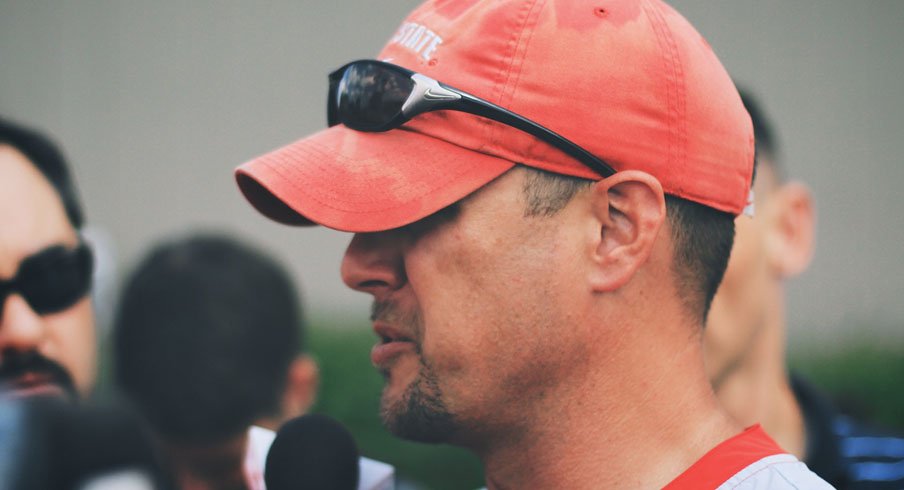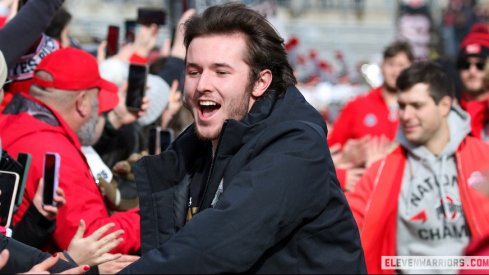Last week we examined Tom Herman's April coaching clinic discussion of Ohio State's run/pass packaged plays. Today we turn to the next portion of his coaching clinic – the Buckeyes' play action passing game.
HERMAN'S HEAD: Run-Pass Combinationas | The QB Run Game
Specifically, Herman discussed Gun Pap – a six man play-action pass protection with a pulling guard.

Making 'Em Bite with Faking
Given the effectiveness of Ohio State's inside run game, the importance of play action should come as no surprise. But it is critical to underscore why the play pass is such a crucial tool.
The rules of football provide the offense and defense certain advantages vis a vie each other. The offense has the advantage of knowing where the football is going. So forcing the defense to play slow because they still do not know where the football will end up following the snap provides the offense that much more of an advantage.
Coaching legend Homer Smith long emphasized that an offense's most important weapon was faking. But not just any faking.
What makes a defender good is something to read. If he can say to himself something like, “As soon as that quarterback makes that half-assed fake, I’m going to find the tightend coming across and try to get an interception,” if he can read initially and react accurately, he can play over his head. Counters, not mirrored primary plays, keep defenders from reading and jumping on plays.
Smith's sentiments regarding the efficacy of play action were echoed by another Hall of Fame Coach -- Bill Walsh.
The Play-Pass is the one fundamentally sound football play that does everything possible to contradict the basic principles of defense. I truly believe it is the single best tool available to take advantage of a disciplined defense. By using the play-pass as an integral pant of your offense you are trying to take advantage of a defensive team that is very anxious very intense and very fired-up to play football. The play-pass is one of the best ways to cool all of that emotion and intensity down because the object of the play-pass is to get the defensive team to commit to a fake run and then throw behind them. Once you get the defensive team distracted and disoriented, they begin to think about options and, therefore, are susceptible to the running game.
Selling Play Action with the Offensive Line
To Smith, the most effective play action mirrored the base run play. That is because, while fans may focus on the quarterback, linebackers and safeties read keys. And one of the most common keys is the offensive guards. The offensive line thus plays a crucial role in selling run action.
And one of the most effective ways to do so is with a pulling guard. As San Francisco 49ers offensive coordinator Greg Roman stated, if you really want play action, you better pull a guard.
Offenses utilizing a pulling guard with play action generally employ a six man gap protection. The front side linemen are all responsible for the gap away from the pulling guard. The guard then takes the end man on the line of scrimmage. Although the offense loses an eligible receiver (or two) with this blocking scheme, it ensures that each gap is covered across the line of scrimmage. And with play action, the goal is often to take shots downfield anyway, rather then have five man routes.
Putting Theory into Practice
This is precisely the framework that Urban Meyer and Herman utilize with Gun Pap. The quarterback fakes a tight zone handoff and half boots the other way. The backside guard pulls and serves as the lead blocker, while the remaining offensive linemen block away (and towards the run fake). The Buckeyes like utilizing deep crossing routes with the scheme.
The Buckeyes likewise utilizing a pulling guard gap protection scheme to run play action off inverted veer. Up front, the line utilizes the exact same power blocking scheme. The quarterback carries out the fake like he is reading the front side defender, but then drops back. Instead of leaving that defender unblocked, the backside pulling guard logs him, creating the pocket. The Buckeyes frequently utilized a deep crossing route from the backside slot with this scheme also.

To paraphrase another constant refrain from Walsh, the drop back passing game is for ball control, while play action is for gaining chunk yards down field. Given that the base of Ohio State's offense is the inside read game – and that defenses must account for Braxton Miller as a runner – play action passes such as these will also remain the Buckeyes' primary method to throw the football down field.


